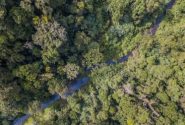
Scientists say that non-timber forest products, like the Brazil nut, should be better integrated into forest management. Photo courtesy of J. Marconi
By Angela Dewan
Earlier today, Verina Ingram of CIFOR, Cameroon, spoke about the overemphasis on timber in forest planning, resulting in a lack of planning for non-timber forest products, such as honey, rubber and nuts.
If the world wants to conserve forests and use land more economically, it is going to have to consider using the same land for more than one purpose.
Other researchers today confirmed Ingram’s observations and shared their case studies of multiple-purpose forest management (MPFM) in tropical forests. They all said that there was an enormous need for greater recognition of non-timber forest products and that there was strong will on the grassroots level to implement MPFM.MPFM can be carried out in various ways, but its overarching concept is that an array of forests products and services should be integrated into forest management and policy.
“When management is based just on timber, it tends to be business oriented, which often leads to conflict with local populations,” said Plinio Sist of CIRAD, a France-based agricultural research centre. “And quite often this means bad logging practices, which can be the first step to conversion into agricultural land.”
Sustainable management, Sist says, must take into account the diversity of forest resources and services, and the interests of different stakeholders, particularly local communities.
“MPFM can provide more regular income than timber production only, especially for local populations,” he said.
While conditions in the Amazonian forests of Brazil are conducive to MPFM, implementation there, and in the tropics in general, has been poor.
Sist attributes this in part to a lack of knowledge of resources and conflict with other activities, like agriculture.
“MPFM is expensive and there is a lack of knowledge about costs and profits,” he said.
Manuel Guariguata, of CIFOR in Indonesia, looked at how forest planning could integrate management of Brazil nut and timber harvesting in the MAP region, which includes Madre de Dios in Peru; Acre in Brazil; and Pando in Bolivia.
To assess how conducive MPFM would be to the MAP areas, he weighed up the strengths, weaknesses, opportunities and threats based on interviews with stakeholders.
“The main strength cited was capacity building, followed by management benefits and additional income from both timber and Brazil nut harvest,” Guariguata said.
“On the other hand, stakeholders agreed that following forestry legislation would be much more expensive than

CIFOR's Robert Nasi says MPFM could ensure greater accountability for those who use land unsustainably and threaten wildlife
just engaging in informal forestry activities.”
A major threat that MPFM could bring is reinvestment of forestry income to cattle, which would destroy land and threaten the abundance of non-timber forest products.
In the Congo Basin, the situation is the same – timber is the only managed forest resource.
Robert Nasi, also of CIFOR in Indonesia, studied the potential for MPFM in the Congo Basin in respect to timber and wildlife.
He said that conserving protected areas alone would not be enough to conserve large and highly mobile species within huge ranges.
An effective MPFM plan to protect wildlife, Nasi said, would imply a clear definition of responsibilities of all stakeholders.
“So if a logging company is operating in a certain area, they would be responsible for that area. People who say you can do log without damage are wrong,” he said.
Logging companies have little incentive to take such responsibility at the moment, which is a barrier to implementing MPFM.
“Another barrier is the high demand for bushmeat from external urban areas and the lack of knowledge about the market chain,” he said, adding that 80 percent of people in Central Africa rely on the meat for protein.
All presenters’ research showed great need and potential for diversifying forest management to reflect the diversity that exists within the forests. They are eager to embark on the next step.
“The conditions favouring or impeding the implementation of MPFM have already analysed in literature,” CIRAD’s Sists said. “But we need to work in the real world to confirm the hypothesis. MPFM is still a theoretical concept.”
We want you to share Forests News content, which is licensed under Creative Commons Attribution-NonCommercial-ShareAlike 4.0 International (CC BY-NC-SA 4.0). This means you are free to redistribute our material for non-commercial purposes. All we ask is that you give Forests News appropriate credit and link to the original Forests News content, indicate if changes were made, and distribute your contributions under the same Creative Commons license. You must notify Forests News if you repost, reprint or reuse our materials by contacting forestsnews@cifor-icraf.org.












